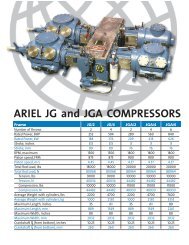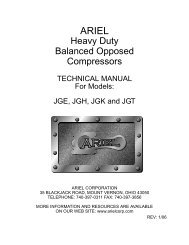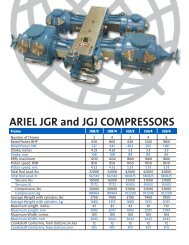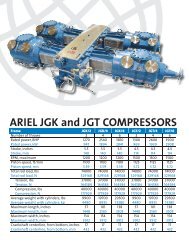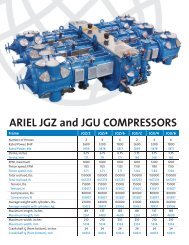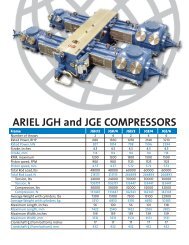Heavy Duty Balanced Opposed Compressors
Heavy Duty Balanced Opposed Compressors
Heavy Duty Balanced Opposed Compressors
You also want an ePaper? Increase the reach of your titles
YUMPU automatically turns print PDFs into web optimized ePapers that Google loves.
FOR MODELS: JG AND JGA SECTION 4 - LUBRICATION AND VENTING<br />
Force Feed Lubrication System and Running Conditions<br />
Force Feed Lubrication System<br />
1. Check sight glass on lubricator reservoir to make sure it is properly filled with oil.<br />
The oil in the reservoir is used to lubricate the worm gear and cam; it does not<br />
flow through the system. The reservoir also catches lube pump overflow. Oil is<br />
added only if it becomes necessary to raise the reservoir oil level. When replacing<br />
lubricator reservoir oil, use new frame oil, except with an independent force<br />
feed supply, then use cylinder oil. If a synthetic oil is used, drain and clean reservoir<br />
before re-filling.<br />
2 The system has been filled with mineral oil at the factory, and unless the piping<br />
has been disturbed, it is ready for operation. If piping has been removed, or if<br />
the system has been drained, it can be filled and primed through a 1/8 inch plug<br />
on the discharge end of the lubricator pump. Priming the force feed lubrication<br />
system requires the use of a priming pump (G-7162); refer to “Ariel Optional<br />
Tools” on page 7-1 and “Priming/Purging the Force Feed System” on page 4-9.<br />
3 If the unit has been overhauled, adjust the lubricator for maximum delivery.<br />
Refer to Figure 5-10:. Loosen the adjusting screw locknut. Turn the plunger<br />
stroke adjustment screw to the full up position. Tighten the adjusting screw locknut.<br />
Proper feed rate may be set after the machine is started.<br />
Running Conditions<br />
When the machine is running, make sure that the oil level in the lubricator reservoir is at<br />
least one-half way up the sight level, but does not exceed two-thirds.<br />
See your packager's specific data to determine the normal operating conditions, the cylinder<br />
working pressures, and the rated speed.<br />
System Design Considerations and Operating Parameters<br />
To optimize force-feed lubrication system operation, Ariel uses the following general guidelines:<br />
1 Minimal use of “master/slave” distribution blocks in favor of lubricator pumps<br />
dedicated to an individual distribution block.<br />
2 Maintain lube ratios within prescribed limits and cycle times as low as possible<br />
(10 sec minimum) to provide each point with lubrication as frequently as possible.<br />
3 Multiple pumps with manifolding are used to ensure that 150% of the normal<br />
lubrication rate can be provided during break-in.<br />
4 Pumps are not allowed to operate below 20% of full stroke, the point at which<br />
they become unreliable.<br />
5 In some applications, to optimize operation of the lubrication system, a single<br />
twin divider output is used to deliver lubrication to both a packing and a cylinder.<br />
6 In some applications, cross-porting of divider valves is used to deliver the proper<br />
11/01 PAGE 4 - 19





